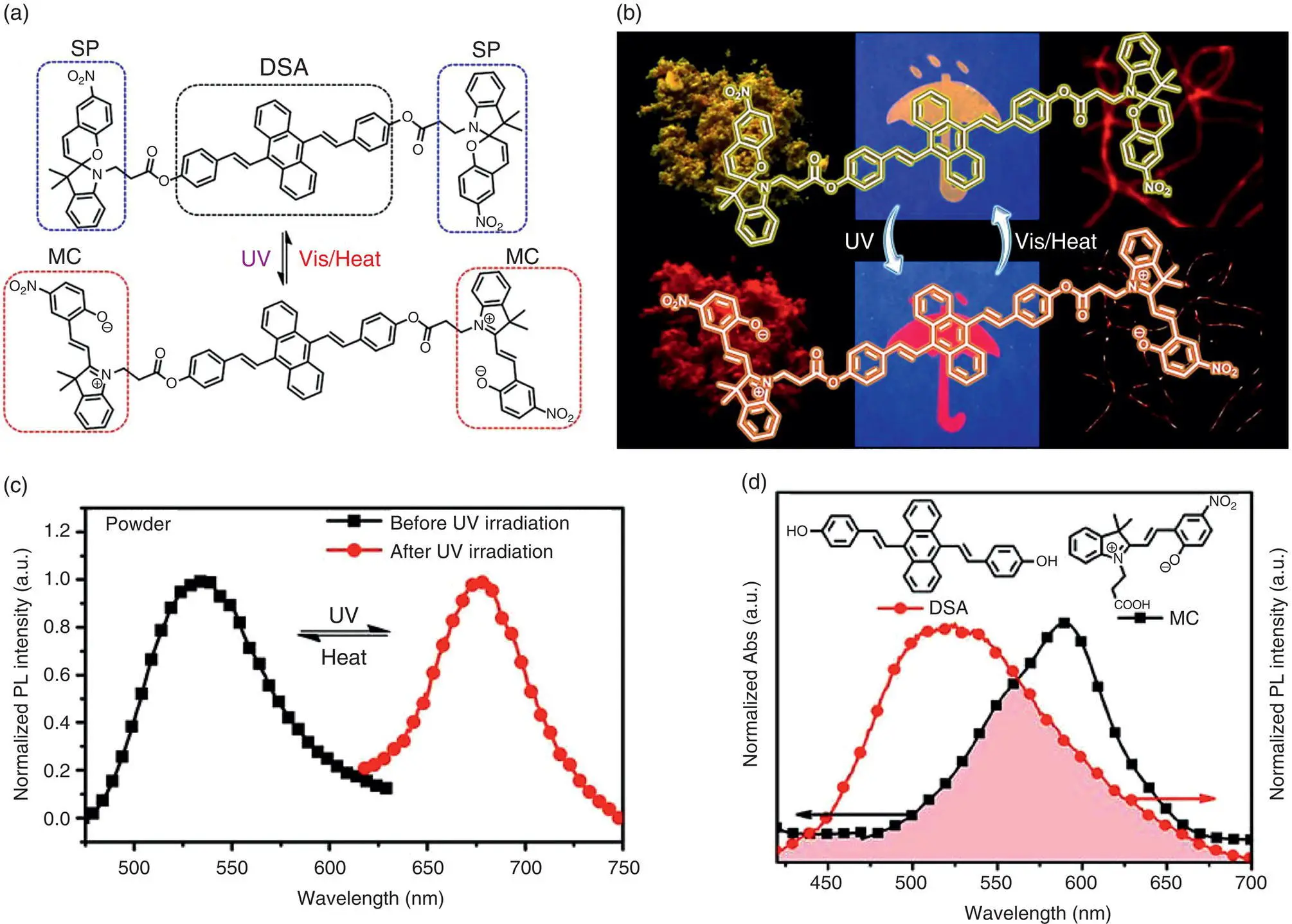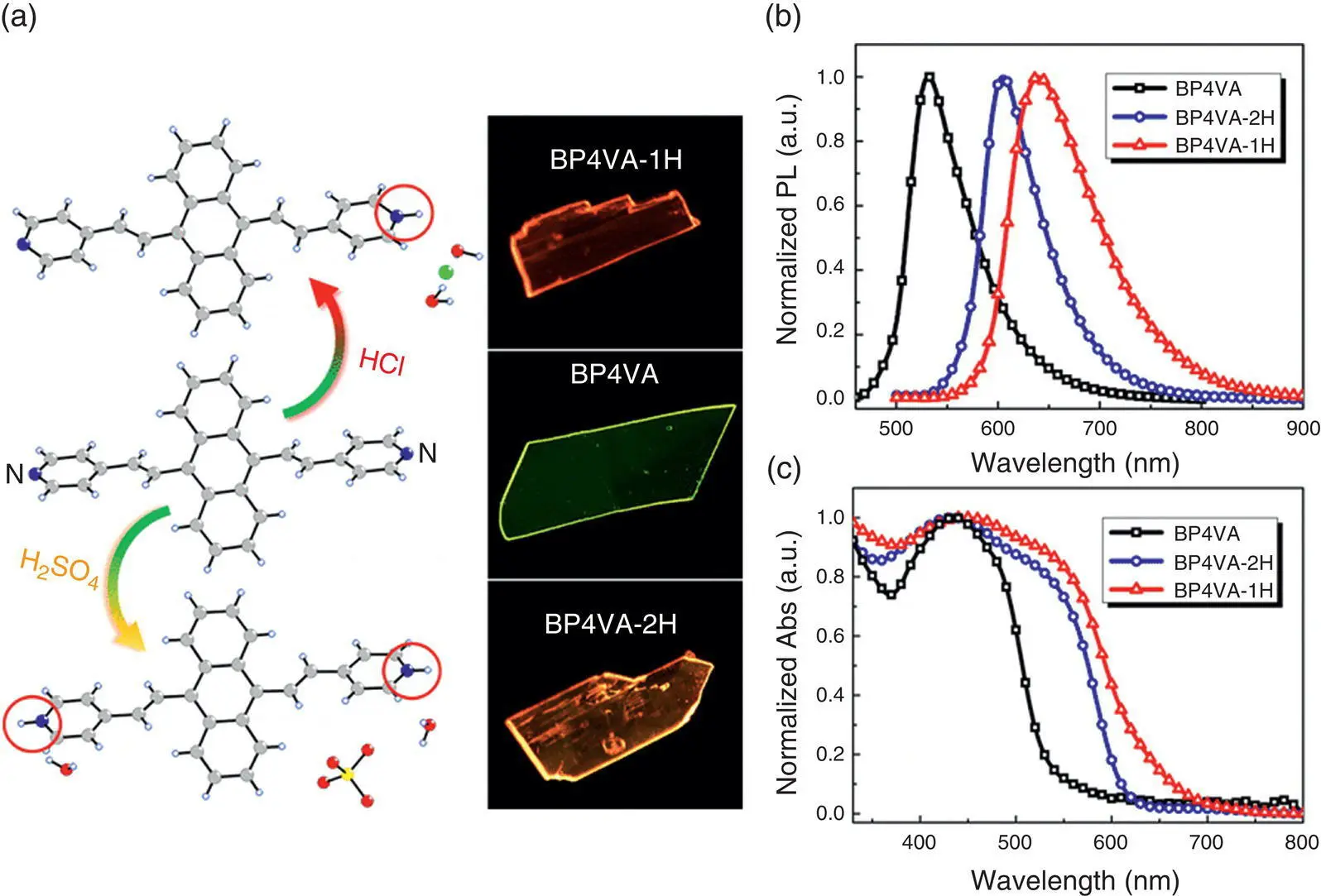Chi et al. reported a series of DSA derivatives 1‐3, 1‐4, 1‐5, and 1‐6(see Figure 2.1), which are substituted by triphenylethylene and tetraphenylethylene [28]. These compounds have the property of aggregation‐induced enhanced emission (AEE), and their fluorescence color changes significantly under pressure. After annealing, they can be restored to the initial state. In addition, all of the four DSA derivatives 1‐7, 1‐8, 1‐9, and 1‐10(see Figure 2.1) substituted by carbazoles have piezofluorochromic properties, and the piezofluorochromic effect of the compound with more carbazole groups is more obvious [29, 30]. By studying the fluorescence changes of the powder under different conditions (grinding, annealing, and solvent treatment), it is proved that the piezofluorochromic properties of the powder can be greatly enhanced by the introduction of the carbazole group in the DSA AEE structure. These excellent properties allow these compounds to be used as stimulus response and luminescent materials in the fields of recording and pressure sensing.
Chi and Yang's group studied a series of DSA‐based compounds 1‐17, 1‐18, 1‐19, 1‐20, 1‐21, and 1‐22(see Figure 2.2) with different alkyl chain lengths [31–38]. It was found that the length and structure of different substituents have significant effects on the piezofluorochromic properties of the DSA macromolecular materials. Combined with the crystal structure, it can be observed that the length of the substituent will affect the conformation of the molecules and change their aggregation structure, leading to different optical properties.
Besides the above DSA derivatives, some other AIE molecules based on DSA with piezofluorochromic properties have also been reported. The effects of different factors such as isomerization of butyl groups, alkoxy‐position, and length of alkoxy chains on the piezofluorochromism were investigated [39–43].
2.2.1.2 Photochromic Materials
Photochromic material refers to a type of material that exhibits the reversible changes of absorption and fluorescence spectra due to the change of molecular structure before and after the light stimulus. In recent years, materials with photochromic properties have been widely concerned by researchers in view of their applications in optical data storage, anti‐counterfeiting, and super‐resolution imaging.
Tian et al. reported a new solid‐state photochromic material 1‐11(i.e. DSA‐2SP) by covalently linking two spiropyran (SP) moieties to DSA [44] (see Figure 2.3a). As shown in Figure 2.3b, under the stimulation of light and heat, the fluorescence of its powder will change reversibly from yellow to red. Figure 2.3c shows the photoluminescence spectra of 1‐11(DSA‐2SP) powders before and after UV irradiation. It can be observed that a red‐shifted emission band peaked at 670 nm appeared after UV exposure. They found that the absorption band of conjugated merocyanine (MC) substantially overlaps with the emission band of DSA (see Figure 2.3d), and the distance between the two moieties is only ∼1.463 nm. Therefore, the donor will transfer energy to the acceptor after the UV stimulation. In addition, the twisted DSA itself can not only afford significant free volume for the photoisomerization reaction of SP but also directly form an intramolecular hydrogen bond with the MC to further stabilize the MC form and lead to more efficient photoswitching between DSA‐2SP and its photoisomer DSA‐2MC. Consequently, it was successfully demonstrated that DSA‐2SP is highly applicable as both anti‐counterfeiting inks and super‐resolution imaging agents due to its excellent solid‐state photochromic property (see Figure 2.3b) [44].
2.2.1.3 Thermochromic Materials
Thermochromism is the phenomenon that the molecules change color with the change of temperature. Lu et al. combined DSA derivative 1‐12with layered double hydroxides to form a bicolor optically active ultrathin film [45]. It switches its fluorescence from yellow to yellowish green when it is heated in the temperature ranges from 25 to –85 °C, and its fluorescence intensity decreases gradually. After it is cooled to room temperature, it returns to its initial state and achieves a reversible change in fluorescence with temperature. This kind of super thin film material with good stability and reversibility has potential applications in sensing and optical display fields.
2.2.1.4 Acidichromic Materials
Acidichromism refers to the phenomenon that the absorption and fluorescence spectra of organic dye molecules change significantly with the change of pH. Organic luminescence materials with acidichromism properties are often used in acid sensor, biological imaging, etc. It is worth noting that the molecules containing nitrogen organic functional groups such as pyridines are prone to protonation to form hydrogen bonds, so the molecules under protonation–deprotonation stimuli will show obvious acidichromism properties in both solution and solid state.

Figure 2.3 (a) Reversible structural isomerization between 1‐11(DSA‐2SP) and DSA‐2MC under different stimuli; (b) solid‐state photoinduced luminescence switch of 1‐11for advanced anti‐counterfeiting and super‐resolution imaging applications; (c) photoluminescence spectra of 1‐11(DSA‐2SP) powders before and after UV irradiation, ex: 410 and 560 nm; (d) overlap of MC absorption and DSA emission spectra, ex: 410 nm [44].
Source : Reprinted (adapted) with permission from Ref. [44]. Copyright © 2017 American Chemical Society.
The fluorescence of DSA derivative 1‐13powders changed from green to orange after being fumed with hydrochloride (HCl) vapor and returned to its initial state after being fumed with triethylamine [46]. The investigation results of X‐ray structural analysis and theoretical calculation confirmed that the change of fluorescence is the result of the enhanced excitonic coupling and electron delocalization.
Different from compound 1‐13, the protonation degree of DSA derivative 1‐2(i.e. BP4VA in Figure 2.4) crystals can be regulated by adding different acids and supramolecular interactions between molecules [47]. The neutral single crystal can emit bright green fluorescence. However, the symmetrical protonation state crystal obtained by adding H 2SO 4shows a red‐shifted orange fluorescence (see BP4VA‐2H in Figure 2.4a), and the fluorescence of the asymmetrical protonation state crystal obtained from adding HCl is further red‐shifted to red (see BP4VA‐1H in Figure 2.4a). Figure 2.4b and c shows the photophysical properties of these 1‐2molecular crystals. The different protonation states of crystals lead to various supramolecular interactions, different aggregation states, and even tunable optical properties. It provides a mechanism for understanding the role of protonation in organic conjugated molecules and a method for expanding the range of organic functional materials.

Figure 2.4 (a) The symmetrical and asymmetrical protonation states of compound 1‐2(i.e. BP4VA in the figure) and fluorescence images of BP4VA, BP4VA‐1H, and BP4VA‐2H crystals; normalized (b) photoluminescence spectra and (c) absorption spectra of BP4VA, BP4VA‐1H, and BP4VA‐2H crystals [47].
Читать дальше














